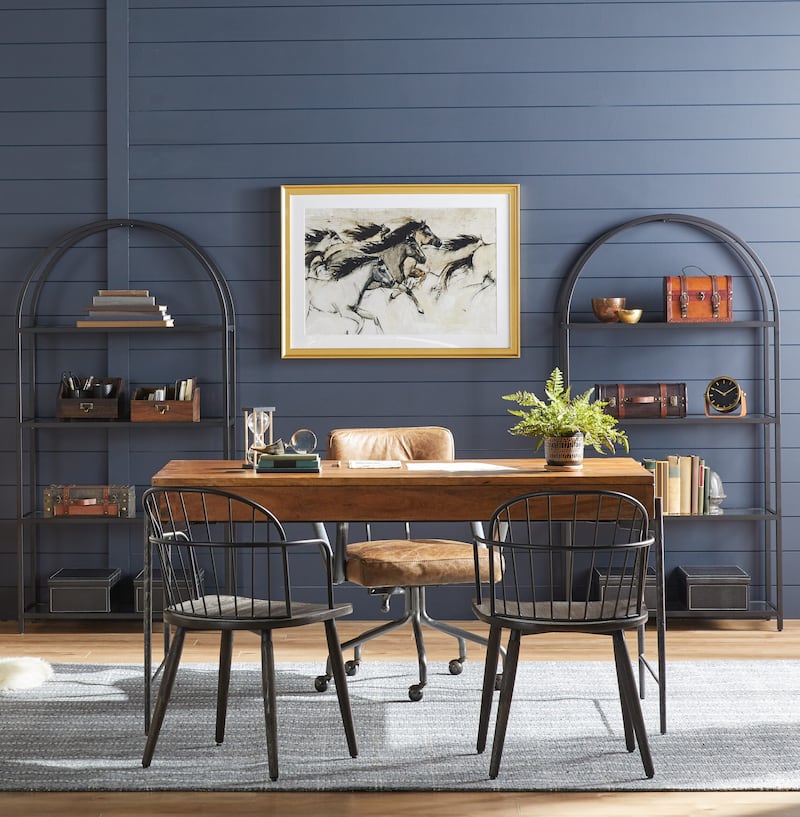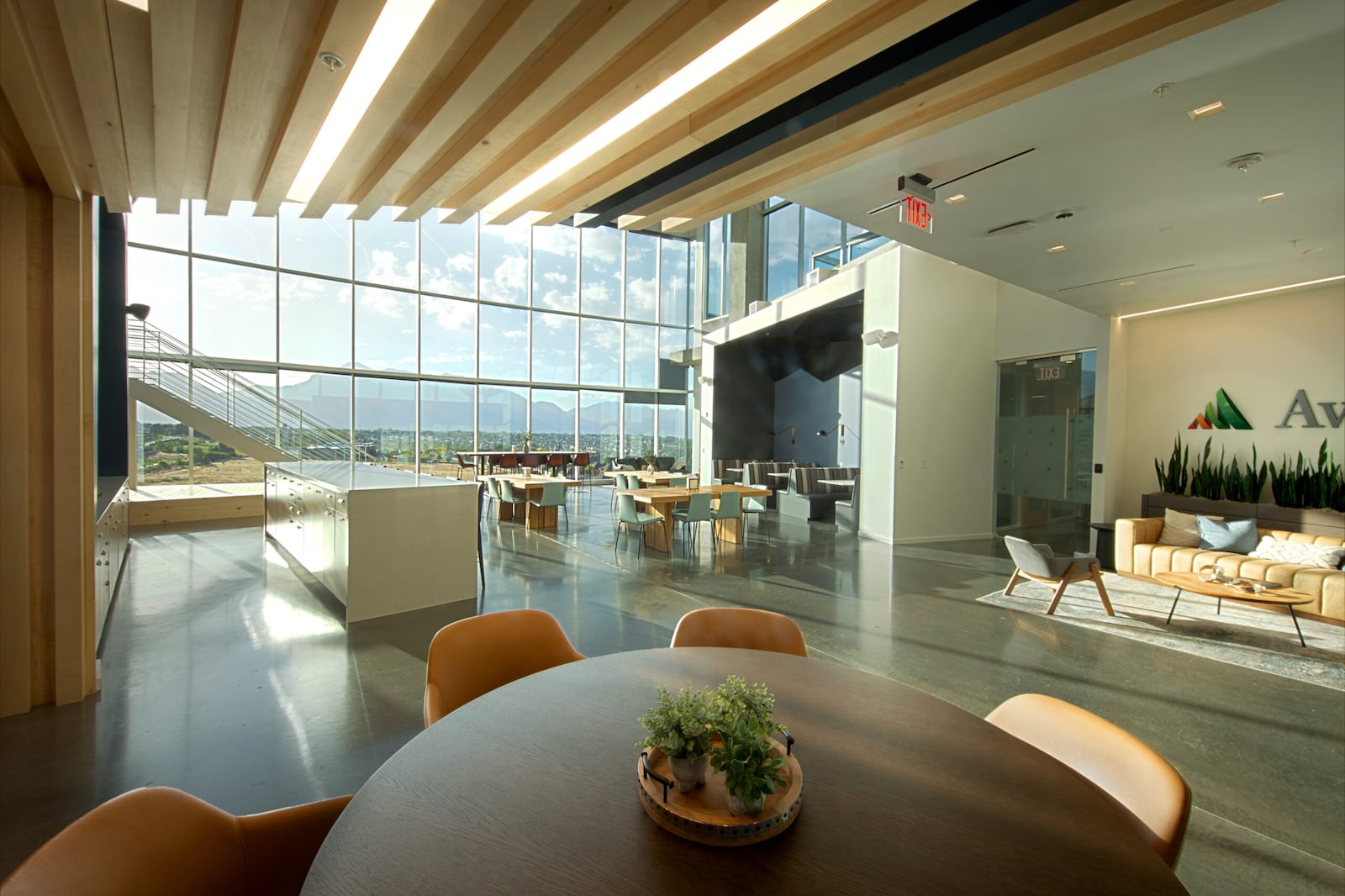This story appears in the July issue of Utah Business. Subscribe.
For many people, the mental transition from home to the office — or even a home office, for remote workers — takes some effort. This transition often involves unconscious reactions to our workspace that impact our mood and behaviors. While many people might agree it is important to have a designated space for doing work, the design and decor of these spaces is often overlooked.
As a former mental health clinician-turned-interior designer and one of only a handful of “design psychologists” with expertise in the connection between space design and mental health, I believe there is an underrated correlation between our mental well-being and the spaces we inhabit.
I spent years in private practice as a therapist before merging my love for design and psychology by developing a college course on the relationship between the two. Read on for a crash course.
Messy desk, messy mind
Similar to an artist with an easel, we need to have our work tools accessible to perform the tasks at hand; otherwise, we may find ourselves feeling avoidant or distracted. This loss of motivation or sapping of energy is known as a “gumption trap.”
One element that often leads to gumption traps in office spaces is clutter. Viewing clutter makes us very tense, as we feel the need to continuously scan cluttered areas to ensure nothing has changed or requires our attention. This dates back to our ancestral survival skills when we would scan our landscapes for danger. In doing so, we divert a great deal of our mental energy and limit our ability to set up our office in a way that promotes productivity or excitement for the task at hand.
Limit the amount of clutter on your desktop area and avoid too many elements at eye level. Humans can process curated clutter much quicker than messy stacks or overflowing boxes, so introduce desktop organizers, under-desk cabinets or adjacent wall storage away from your line of sight.
Having organizational systems in place also leads to healthier behaviors in the office. Much like a sleep routine, creating a work routine aids in signaling to the brain and body that it’s either time to work or time to shut down. Placing items in their respective “home” at the end of your day cues the mind that it’s time to transition out of work. Pulling them back out the next day signals that it’s time to focus.
The power of color
Warmer colors feel as though they are advancing or moving toward us. Leaning into these colors in an office can help it feel cozier and psychologically warmer. If your office runs cooler in temperature or if it feels a bit too large, consider going warmer with your wall color or artwork to counteract these environmental features.
Conversely, cool colors give the impression of receding or pushing away from us. These colors help a space feel larger and psychologically calm. If you are working with a small office footprint that feels cramped, opt for a cooler palette on the walls or throughout the space to help it feel larger.
If color isn’t your thing, this same outcome can be achieved with neutrals. Since whites, grays and taupes typically have warm or cool undertones, look for the corresponding tone in a range of neutral hues. Keep in mind that primarily white or beige environments can lead to users of the space feeling understimulated and restless. Be mindful of creating range in your color palette to combat this effect.
One color to avoid, however, is red. This bold color has been shown to limit our ability to focus or access previously learned information, making it a tough choice for office spaces. We tend to feel more quickly defeated around this hue, especially brighter, more saturated versions.
To amp up the energy in your office space, incorporate complementary colors — the colors found opposite one another on the color wheel. Avoid pairing two highly saturated contrasting colors, however, as this can feel overwhelming after long periods of time. A successful combination might be a deep navy on office walls married with a chalky terra cotta orange in contrast.
If you find yourself anxious or stressed out in your office, consider using a monochromatic color scheme. When subtle variations of the same color are used together, they can have a relaxing and calming effect on humans. An example of this palette is working with a deep vegetal green and using a range of greens down to a pale sage.
Nature’s prescription
Biophilic design suggests humans possess an innate tendency to seek a connection with nature and other forms of life. The practice of this concept often aims to blend indoor spaces with the outdoors through plant life, views of nature, organic materials and imperfect shapes.
Biophilic design plays a major role in our productivity levels and emotional state. When we have exposure to natural light and views of the outside world in work areas, we experience increased well-being, productivity and energy. Elements and features that replicate the outdoors — such as wood, stone, irregular shapes and photography of nature (when views are not possible) — are a few ways to enhance this innate connection we have to the Earth.
There is significant evidence pointing to the use of wood as a powerful material in design. Viewing wood grain increases our emotional well-being and can significantly lower stress levels. This makes a case for using a wood desk, adding wood paneling to an office wall or perhaps using wood decor throughout the space.
Related to our connection with nature is the prospect-refuge theory. This theory calls out our preference to spend time in places that feel like refuge, with lower ceilings and dim lighting. We feel safe and protected in spaces that somewhat reference an environment we may have sought shelter in during our distant past.
While in these spaces, we like to look out and see areas known as “prospects” — brighter areas with higher ceilings or no ceilings at all. This theory essentially speaks to our need for protection and planning, as we enjoy feeling safe and protected but also take comfort in being able to map out our path should we need to relocate.
While we do not rely on these survival skills in the same way we used to, you can elicit the same feelings of safety and comfort through a few design tricks. You might choose to vary the ceiling height in your office, for example, keeping it lower above your desk area. You can also anchor your office from above by adding an oversized pendant over your desk, creating the sense of a protected canopy. Or, simply orient your desk facing a window — the office becomes your refuge while the outside space is your area of prospect.
Exposure to sunshine helps regulate our circadian rhythms, helping us feel more regulated overall and achieve balance with our sleep and wake cycles. Ensuring exposure to natural light throughout the day is incredibly helpful to our psyche.
When employees are allowed views of nature, they spend more time on work-related tasks and are around 15 percent more productive. If your office space has limited natural light or views to the outside, place mirrors on the wall adjacent to the window. This will act as a secondary window, reflecting the natural light and helping the space feel more expansive and connected to the outside.
Combating emotional fatigue
When Einstein would get stuck on a math equation, he would play the violin. Using the other side of our brain strengthens communication between the two hemispheres, making a case for carving out an area for non-work-related items in your office. This might be a guitar displayed on the wall that can be played between meetings, a lounge chair for doing a crossword or puzzle, floor space to lay out a yoga mat for a quick stretch, and so on.
It is important to create the option for privacy in offices, whether that is through actual doors, window treatments, privacy screens, sound machines or other means. According to research by environmental psychologist Sally Augustin, humans value auditory privacy over visual privacy — if given the option to be heard or seen, we would prefer others are not able to hear us. This makes office planning tricky, but having the option for a minimum of auditory privacy is helpful.
A significant reason for privacy involves the interruptions we face in a workday. When we are involuntarily interrupted, it takes an average of 25 minutes to return to the original task. This means we lose around one hour of productivity per day if faced with only three distractions.
Quick takeaways
From color choices to the incorporation of nature and the importance of organization, many factors contribute to our ability to self-regulate, relax or feel creative in our offices.
If you are overwhelmed by where to start, I suggest tapping into the way you want to feel in your office. Want to be more energized and productive? Start with a little decluttering and a design refresh in a contrasting color palette.
If your work is high-stress and you need to feel more calm, opt for a monochromatic color story and layer in warm woods and organic shapes. Allowing the desired feeling for your office to guide your design decisions is a great way to achieve a design more catered to your psychological needs.


